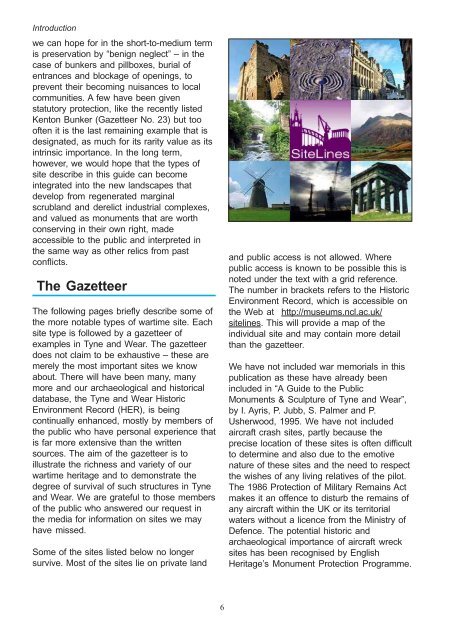TWENTIETH CENTURY DEFENCE SITES of TYNE and WEAR
TWENTIETH CENTURY DEFENCE SITES of TYNE and WEAR
TWENTIETH CENTURY DEFENCE SITES of TYNE and WEAR
Create successful ePaper yourself
Turn your PDF publications into a flip-book with our unique Google optimized e-Paper software.
Introduction<br />
we can hope for in the short-to-medium term<br />
is preservation by “benign neglect” – in the<br />
case <strong>of</strong> bunkers <strong>and</strong> pillboxes, burial <strong>of</strong><br />
entrances <strong>and</strong> blockage <strong>of</strong> openings, to<br />
prevent their becoming nuisances to local<br />
communities. A few have been given<br />
statutory protection, like the recently listed<br />
Kenton Bunker (Gazetteer No. 23) but too<br />
<strong>of</strong>ten it is the last remaining example that is<br />
designated, as much for its rarity value as its<br />
intrinsic importance. In the long term,<br />
however, we would hope that the types <strong>of</strong><br />
site describe in this guide can become<br />
integrated into the new l<strong>and</strong>scapes that<br />
develop from regenerated marginal<br />
scrubl<strong>and</strong> <strong>and</strong> derelict industrial complexes,<br />
<strong>and</strong> valued as monuments that are worth<br />
conserving in their own right, made<br />
accessible to the public <strong>and</strong> interpreted in<br />
the same way as other relics from past<br />
conflicts.<br />
The Gazetteer<br />
The following pages briefly describe some <strong>of</strong><br />
the more notable types <strong>of</strong> wartime site. Each<br />
site type is followed by a gazetteer <strong>of</strong><br />
examples in Tyne <strong>and</strong> Wear. The gazetteer<br />
does not claim to be exhaustive – these are<br />
merely the most important sites we know<br />
about. There will have been many, many<br />
more <strong>and</strong> our archaeological <strong>and</strong> historical<br />
database, the Tyne <strong>and</strong> Wear Historic<br />
Environment Record (HER), is being<br />
continually enhanced, mostly by members <strong>of</strong><br />
the public who have personal experience that<br />
is far more extensive than the written<br />
sources. The aim <strong>of</strong> the gazetteer is to<br />
illustrate the richness <strong>and</strong> variety <strong>of</strong> our<br />
wartime heritage <strong>and</strong> to demonstrate the<br />
degree <strong>of</strong> survival <strong>of</strong> such structures in Tyne<br />
<strong>and</strong> Wear. We are grateful to those members<br />
<strong>of</strong> the public who answered our request in<br />
the media for information on sites we may<br />
have missed.<br />
Some <strong>of</strong> the sites listed below no longer<br />
survive. Most <strong>of</strong> the sites lie on private l<strong>and</strong><br />
6<br />
<strong>and</strong> public access is not allowed. Where<br />
public access is known to be possible this is<br />
noted under the text with a grid reference.<br />
The number in brackets refers to the Historic<br />
Environment Record, which is accessible on<br />
the Web at http://museums.ncl.ac.uk/<br />
sitelines. This will provide a map <strong>of</strong> the<br />
individual site <strong>and</strong> may contain more detail<br />
than the gazetteer.<br />
We have not included war memorials in this<br />
publication as these have already been<br />
included in “A Guide to the Public<br />
Monuments & Sculpture <strong>of</strong> Tyne <strong>and</strong> Wear”,<br />
by I. Ayris, P. Jubb, S. Palmer <strong>and</strong> P.<br />
Usherwood, 1995. We have not included<br />
aircraft crash sites, partly because the<br />
precise location <strong>of</strong> these sites is <strong>of</strong>ten difficult<br />
to determine <strong>and</strong> also due to the emotive<br />
nature <strong>of</strong> these sites <strong>and</strong> the need to respect<br />
the wishes <strong>of</strong> any living relatives <strong>of</strong> the pilot.<br />
The 1986 Protection <strong>of</strong> Military Remains Act<br />
makes it an <strong>of</strong>fence to disturb the remains <strong>of</strong><br />
any aircraft within the UK or its territorial<br />
waters without a licence from the Ministry <strong>of</strong><br />
Defence. The potential historic <strong>and</strong><br />
archaeological importance <strong>of</strong> aircraft wreck<br />
sites has been recognised by English<br />
Heritage’s Monument Protection Programme.

















